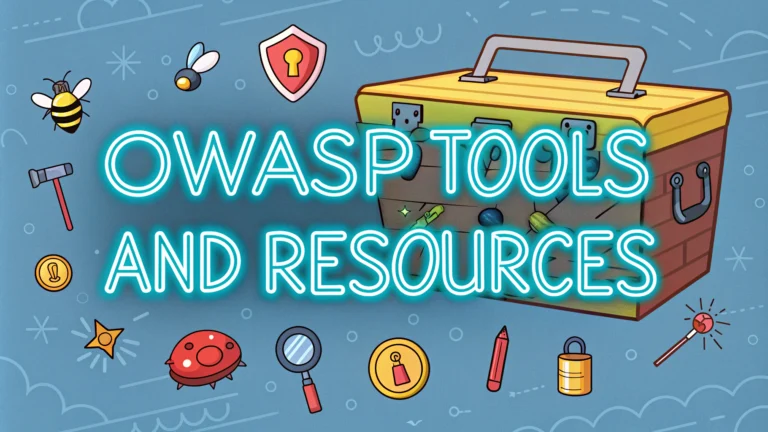OWASP (Open Web Application Security Project) provides security professionals with essential tools and resources for conducting thorough penetration testing.
Popular OWASP Testing Tools
- ZAP (Zed Attack Proxy) – Free security testing tool for finding vulnerabilities in web applications
- OWASP Dependency-Check – Detects publicly disclosed vulnerabilities in project dependencies
- WebGoat – Deliberately insecure application for learning application security
- OWASP Juice Shop – Modern vulnerable web application for security training
- Amass – In-depth attack surface mapping and asset discovery tool
Key OWASP Testing Resources
- Web Security Testing Guide (WSTG) – Comprehensive web application testing methodology
- Mobile Security Testing Guide (MSTG) – Mobile app security testing procedures
- API Security Top 10 – Focus areas for API security testing
Getting Started with OWASP Tools
- Download ZAP from zaproxy.org
- Set up WebGoat on your local machine for practice
- Join the OWASP Slack community for support
- Review the WSTG documentation for testing methodologies
Testing Categories
| Category | Focus Areas |
|---|---|
| Information Gathering | Fingerprinting, Enumeration |
| Configuration Testing | SSL/TLS, Security Headers |
| Authentication Testing | Session Management, Access Controls |
| Input Validation | SQL Injection, XSS, CSRF |
Best Practices
- Always obtain proper authorization before testing
- Document all findings with clear evidence
- Use multiple tools to validate findings
- Keep tools updated to latest versions
- Follow the OWASP Testing Framework methodology
Contact the OWASP Foundation at [email protected] for additional support or visit owasp.org for more resources.
Advanced Testing Techniques
Automated Scanning
- Configure scheduled scans with ZAP automation framework
- Integrate security testing into CI/CD pipelines
- Set up custom scan rules and policies
- Generate comprehensive reports automatically
Manual Testing Approaches
- Business logic vulnerability assessment
- Authentication bypass attempts
- Session manipulation techniques
- Custom exploit development
Reporting and Documentation
- Use standardized templates for consistency
- Include clear reproduction steps
- Prioritize vulnerabilities by risk level
- Provide actionable remediation guidance
- Include technical and executive summaries
Compliance and Standards
| Standard | Key Requirements |
|---|---|
| PCI DSS | Regular Testing, Vulnerability Management |
| ISO 27001 | Security Assessment, Risk Management |
| GDPR | Data Protection, Privacy Controls |
| HIPAA | Security Evaluation, Access Controls |
Conclusion
OWASP tools and resources provide a robust framework for comprehensive security testing. Regular updates, community engagement, and continuous learning are essential for maintaining effective security testing practices. Organizations should implement a combination of automated and manual testing approaches while ensuring compliance with relevant standards and regulations.
Remember to:
- Stay current with emerging threats and vulnerabilities
- Participate in the OWASP community
- Regular tool updates and training
- Document and share knowledge responsibly
FAQs
- What are the most essential OWASP tools for penetration testing?
OWASP ZAP (Zed Attack Proxy), OWASP WebGoat, OWASP Juice Shop, OWASP Amass, and OWASP Dependency Check are among the most essential tools maintained by OWASP for security testing. - What is OWASP ZAP and how is it used in penetration testing?
OWASP ZAP is a free security testing tool that acts as an intercepting proxy, allowing testers to find security vulnerabilities in web applications through automated scanning and manual testing features. - How does OWASP WebGoat help in learning penetration testing?
WebGoat is a deliberately insecure web application designed to teach web application security lessons, allowing users to test vulnerabilities like SQL injection, XSS, and CSRF in a safe, legal environment. - What is the OWASP Testing Guide and why is it important?
The OWASP Testing Guide is a comprehensive manual that provides a framework for web application penetration testing, including testing procedures, methodologies, and tools for identifying security vulnerabilities. - How can OWASP Dependency Check improve application security?
OWASP Dependency Check identifies project dependencies and checks if there are any known, publicly disclosed vulnerabilities, helping prevent the use of components with known vulnerabilities. - What role does OWASP Juice Shop play in penetration testing practice?
OWASP Juice Shop is a modern vulnerable web application that contains the OWASP Top 10 vulnerabilities and additional security flaws, providing a realistic environment for security testing training. - How does OWASP Amass assist in penetration testing reconnaissance?
OWASP Amass performs network mapping of attack surfaces by gathering information from numerous sources, including DNS, search engines, and SSL certificates, to aid in the reconnaissance phase. - What are OWASP Mobile Security Testing Tools?
OWASP provides various tools for mobile security testing, including the Mobile Security Testing Guide (MSTG) and Mobile App Security Checklist, which help identify vulnerabilities in mobile applications. - How can OWASP Security Knowledge Framework benefit penetration testers?
The Security Knowledge Framework provides a knowledge base of security requirements and implementation guidelines, helping testers understand security controls and verification methods. - What is OWASP DefectDojo and how does it help manage penetration testing results?
DefectDojo is a security program and vulnerability management tool that helps track and manage findings from security tools, making it easier to organize and report penetration testing results.







